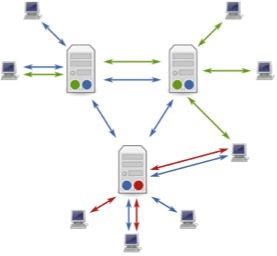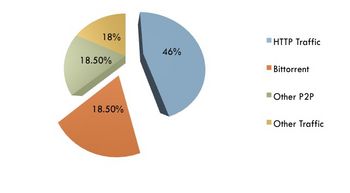Group 1: Dwernychuk, Evans, Gjata, Kanji (File Sharing Technologies)
The information age simplified our lives by placing huge amounts of information at our fingertips. Movies, music, documents, software, are all accessible through the internet. Necessity is the mother of invention; so many different ways to share these files have been invented. File sharing has become a part of everyday life. File sharing affects how you share a photo with your friend. It also affects how you purchase a movie or game online. It is as much of a part of our culture as it is of our counter-culture as it is used for both legal and illegal means.
Contents
Project Overview
The many types of file sharing networks can be very confusing. This project aims to clarify the differences, benefits and drawbacks to each and conclude with a brief verdict on which system is best suited to each use. The aim of this project is to:
- Give an overview of some of the main file sharing technologies
- Provide benefits and drawbacks to each system
- Give an opinion as to which system is best suited for which use
History
Peer-to-peer (P2P) file sharing is used for distributing large amounts of data, particularly audio/ large video files from one user to another and accounts for a massive amount of internet traffic. First generation P2P transferring began with images, moved to audio, and then provided the ability to transfer video files from one user to another. Entities providing these services are known as P2P clients and the most infamous first generation client was known as Napster. As a result of engineering faults these first generation P2P clients were forced to be remodelled into online music stores due to a series of highly publicized copyright lawsuits. As a result of these altercations the popularity of the 1st generation P2P networks started to decline and the second generation bit torrent transfer began to fill the gap.
The BitTorrent movement managed to build a massive following of users almost instantly likely due to the declining quantity and quality of files available on remaining first generation clients. The client providers identified the errors of the first generation and engineered a service far superior. They provided all that the previous generation offered whilst minimizing their exposure to copyright issues and provided tools that were free from spy-ware and ad-ware. Today downloads are independent of client network, and are accessible by anyone, anywhere. This provides people the ability to transfer large files without the intermediary host being eligible for copyright lawsuits. Furthermore, technology is advancing and the internet is becoming more about video than ever before, causing the bit torrent method of file transfer to grow exponentially. A video starring Ashwin Navin, which has been posted on his blog, outlines the history of BitTorrent rather well. This growth has sprouted unlikely partnerships to the point where major movie studios, record labels and video publishers from across the world are identifying positives and licensing their content to bit torrent client providers. Ashwin Navin was interviewed as to the history of the BitTorrent protoco]
Newsgroups
Overview
A newsgroup acts as a warehouse within the Usenet system – a worldwide distributed Internet discussion system. It archives messages posted from many users in many places. A newsgroup is usually a discussion group but is technically distinct from discussion forums. These warehouses are accessed by Newsreader software. A newsgroup is normally formed on the basis of a particular topic of interest. However some groups are designed to accommodate messages that cover a wide variety of topics. Each group has a news admin who decides how long articles are kept on his/her server before they are deleted. This can range from one or two weeks to several months. Newsgroups act as like public message boards that are a valuable source on information, support, and friendship as it brings together different people around the world who are interested in similar topics. It also varies in popularity with some groups receiving only a few posts a month to others that obtain thousands a day.
How It Works
Various institutions and organizations play host to newsgroup servers as well as most internet service providers. When a user posts a message to one server, that message is stored locally. It then shares the message to all other connected servers. Newsgroups are more often than not arranged into hierarchies, which, by theory, make it easier on the user to find related groups. The prefix placed before the first dot is called the top-level hierarchy and it tells the user the type of discussion a specific newsgroup is. Examples include:
- sci. – Scientific subjects
- soc. – Social issues
- rec. – Recreational activities, such as games and hobbies.
There are also internal hierarchies that are used within a company (e.g. hp. is an internal news group for the IT company Hewlett-Packard). Hierarchies also exist for certain languages and countries. Newsgroups can sometimes get confused with chat rooms despite some key differences. For example, chat rooms happen in real-time whereas newsgroups do not. In a newsgroup a person will post a message and later on in that day, week, etc. someone will read it and respond to it. A user tends to put more time and thought into his/her respective post as he/she has time to respond to it. The lack of real-time communication allow topics to become more of a discussion.
Statistics
- College students who wanted to make communication between campuses easier developed the newsgroup concept in 1979.
- Newsgroups (and Usenet) are one of the Internet’s oldest applications. In fact, it is 10 years older than the World Wide Web.
- The term ‘spam’ was first used to describe an unsolicited commercial post.
- Internet Movie Database (IMDb) was created by members of the rec.arts.movies newsgroup.
BitTorrent
Overview
BitTorrent is perhaps the most popular file sharing technology. In its short life span since creation in mid 2001 by Braham Cohen until now, it has grown into a massive network. The estimated number of users online at any given point as of 2006 was over 10 million . Currently, ThePirateBay, one of the most popular trackers, numbers in 12 million online for its tracker alone. The estimated amount of information shared within the network is said to be over 1.1 petabytes. To put this into perspective, this number represents roughly the same amount of information as 1.7 million CDs or 400 thousand DVDs. BitTorrent has caused a huge legal frenzy because of the large amounts of pirated music, movies and software that are shared through this network. The surge in popularity of BitTorrent had seen it jump to a 35% share of the total amount of bandwith on the internet by 2004. The current share of bandwith taken up by BitTorrent has been dwarfed by the growth of video streaming sites like YouTube and Hulu, but still remains one of the top used protocols with an estimated 18.5%. YouTube, Hulu and other video streaming sites are estimated to cause roughly half of http traffic, coming in at approximately 25% of the total internet traffic. This is part of the reason many of the broadband internet providers throttle down BitTorrent traffic.
History
The original BitTorrent protocol was designed by Braham Cohen in April 2001, and its first implementation was in July 2001. Cohen also wrote his own Bittorrent client, which is still managed by his firm, Bittorrent Inc. The large amount of growth prompted a wide amount of legal concerns to surface. Organizations like the MPAA and the RIAA started taking legal actions both against individual downloaders and tracker operators started taking place. December 2004 saw a large wave of legal action. Most notably against popular torrent tracker Suprnova.org, based in Slovenia. 2005 saw Cohen singing a deal with Hollywood. 2006-2007 popular broadband internet providers Comcast, Shaw, Telus, and many other ISP’s around the world started rolling out throttling down of download speeds for clients with bittorrent use. In 2008 the CBC became the first broadcaster to utilize bittorrent as a distribution system for content.
How It Works
The technology behind BitTorrent is very complex while building on a very simple concept. A “seed” makes a file available to the network. “Peers” locate this “seed” using the tracker and start downloading file chunks from it. When a peer finishes downloading a file it then becomes a seed and uploads chunks of the file to the other peers. As more peers join the network, file chunks are downloaded not in order but rather based on piece rarity, from most rare to least rare, in order to keep the availability of the file up. The network is also structured in such a way that the more people are in the swarm, the more connections a single client can make, and the faster a file can be downloaded. Decentralized tracking, a fairly recent development in the technology, allows bittorrent to function without the need for a server to keep track of the peers.
Benefits
- Removes dependence on the original file sharer
- Enough redundancy in the system to maintain availability of the file
- The higher the demand, the faster the download speed
- Very well suited to large files, movies, music albums, software, etc
- Low hardware and network bandwith cost as it spreads the system load
Drawbacks
- Some problems with “leeching” file sharers who download, but don’t upload back
- Clients don’t have much anonymity as individual client IP addresses are plain and visible
- Large problem with pirating
Peer-to-Peer Sharing
Overview
Peer to peer file sharing refers to a direct client to client connection, as opposed to a client to server connection or a client to many connections. This is a broader name for a wide variety of technologies like the Gnutella or Kazaa networks.
How It Works
Some of these networks are centralized in nature, the most popular example being Napster. In this case a central server keeps track of all the peers in the network. Others, like Kazaa are decentralized, needing no central server to keep track of the peers. A variation of this type is the very popular Gnutella network, which finds clients by first finding one node, requesting a list of known nodes from that one, connecting to the rest, and discovering more and more nodes through this web of nodes. In all these cases when a user searches for a file, a request is sent out to every single node in the system, and a response comes back from the nodes that have the requested file. These types of technologies have also been used in a variety of applications ranging from file piracy, to business, miliraty, and educational use.
Benefits
- Very quick and efficient for smaller files such as songs or small movies.
- Can be easier to locate “rare” files.
- The capacity of the system increases as the number of nodes increases, the capacity essentially increases as the network itself grows.
- A lot more robust than a client-server relationship, where if the server goes down the entire network goes down, server-client relationships also have massive hardware and network bandwith costs on the server.
Drawbacks
- File availability not as good
- High demand on a single node can severely decrease the download speed from all nodes connected to it.
- Not very well suited for large files.
Legality of File Sharing
Major record and movie companies argue that file sharing copyrighted files is illegal. These companies have been trying to fine or sue individuals who are involved in file sharing but have been unable to form a solid case.
While there has been many attempts to present legal action to individuals, only one case has gone forward to trial. The RIAA sued Jammie Thomas for $222,000. The RIAA's theory that was that Jammie "made available" 24 song files. The judge whom presided over the trial overturned the verdict, on the grounds that his submission of the case to the jury under the RIAA's "making available" theory was a "manifest error of law". He also criticized the size of the verdict as "wholly disproportionate" to the damages, as they were valued at $25.
It is difficult to initiate and enforce legislation regarding file sharing and interpreting Copyright law. A few factors as to why it is difficult is as follows:
- The new challenges posed by international communications and varying legislations
- Mass litigation and the development of processes for evidence and discovery
- Rapidly developing new technologies and uses
- Low barriers to entry by would-be sharers and the development of a mass usage of the technologies
- File sharing approaches developed in response to litigation against sharers, which obfuscate or hide the fact that sharing is happening, or the identities of those involved. For example: Encryption and Darknets.
Ethics
Such legal issues force a user to ask his/herself two questions:
- By downloading copyrighted content for our own use, we benefit from artists hard work, and they make no money. Shouldn’t they be paid for it?
- Artists do make substantial sums of money through concert tours, endorsement deals, album sales, etc, and downloading could be a form of free advertisment.. But to what end?
Conclusion
- BitTorrent is better suited for larger files
- P2P Networks are better suited for smaller files.
References
- http://www.squidoo.com/BitTorrentHistory
- http://torrentfreak.com/video-ashwin-navin-on-the-history-of-bittorrent/
- http://www.post-gazette.com/
- http://perifericbiennial.files.wordpress.com/
- http://www.masternewmedia.org/
- http://cnettv.cnet.com/i/bto/20070516/
- http://envezdelpsiquiatra.files.wordpress.com
- http://en.wikipedia.org/wiki/Newsgroup
- http://www.compar.com/infopool/articles/news2vs3.html
- http://www.usenetpedia.com/usenet-facts.html
- http://google.com/trends/viz?q=bittorrent&graph=weekly_img&sa=N
- http://www.businessweek.com/technology/content/may2006/tc20060508_693082.htm
- http://torrentfreak.com/the-pirate-bay-smashes-12000000-bittorrent-users-080424/
- http://en.wikipedia.org/wiki/BitTorrent_(protocol)
- http://mattbrennan.ca/cat_music_biz.html


